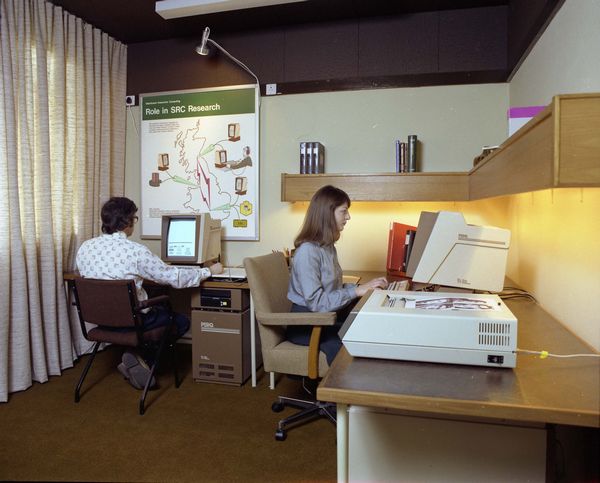

The emergence of cheap high powered single user computer systems with good interactive capabilities and standard communications interface heralds a completely new way for many research workers to achieve the major part of their computing requirements.
Within the next few years, many such systems will be available from different manufacturers. Consequently there is a danger of a variety of machines being employed in academic research, many of which are likely to have inadequate and incompatible systems software, leading to a dissipation of resources and considerable duplication of basic software development.
SERC sees a need for a coordinated plan to ensure that the academic community makes the best use of the resources available to it, especially its limited manpower. The Council has therefore decided on a policy of creating a common hardware and software base to act as a nucleus for future developments in single user workstation practice. Initially, the common software base will be Pascal and FORTRAN running under the Unix operating system implemented on the common hardware base of PERQ single user computers, linked locally by Cambridge Rings and nationally by the X-25 wide-area computer network. The PERQ will be joined by other machines as new products become available.
To assist in the implementation of this policy a small support team is being formed at the Rutherford Appleton Laboratory whose role will be to ensure that the systems software provided on the chosen machine types is satisfactory and to encourage the development of applications software through arrangements analogous to those of the ICF's Special Interest Groups. SERC's Boards and committees will consider grant applications involving requests for single user computers in the normal way. If the scientific programme is approved, the application will be referred to the support team who will arrange the supply of a machine to the applicant. All purchases will come from Board or committee funds but the single point of procurement will enable bulk orders to be placed so that discounts and reductions in delivery times can be obtained. Central purchasing of PERQs, the UK manufacture of which is due to begin in early 1982, will enable ICL to increase the scale of its production with greater confidence. An integral feature of Council's overall strategy is that SERC and ICL will collaborate extensively on the development of future PERQ-type machines and on software systems relevant to the interests of the academic community.
The PERQ is an extremely powerful, single user workstation with a high precision display system which provides a significant improvement in the quality and speed of interaction. Although entirely self-contained, it also features standard communications interfaces offering network access to other local workstations or remote shared facilities. Its principal characteristics are:
Approximately 1 million high level machine instructions per second giving around two-thirds the CPU power of a VAX 11/780. The CPU is micro-programmable for further speed gains.
A4 size, 1024 × 768 pixel, high resolution black and white display featuring 60Hz non-interlaced refresh rate which enables pictures to be moved cleanly and rapidly as well as giving a significant improvement in the clarity of text and diagrams equal to a printed A4 page.
A 2-D tablet keyboard and voice synthesiser, allied to the high quality screen, enables a much improved man-machine interface to be created.
A 32-bit address, paged virtual memory system.
A 24 Mbyte Winchester disk and 1 Mbyte floppy give a single user a large amount of local storage capacity.
Local communication at 10 Mbits/sec via Cambridge Ring. Standard RS-232 serial and IEEE 488 parallel interfaces are also provided.
The whole academic community, not just computer science interests, is a major user and developer of software. The ease with which software can be developed and the extent to which it is easily interchangeable between machines can have a significant effect, therefore, on scientific productivity. The SERC believes that the programme it has initiated for single user machines will provide a way of removing many constraints on research output. Computing resources will be available locally with much greater freedom of access. Person to person and computer to computer links will be easier to establish and the prospects for collaboration and coordination improved. Commonality of hardware and software will maximise the opportunities for cooperation. A framework will be created in which software skills can be exploited, information on tools and techniques disseminated, and software made available in forms which can readily be adopted by the widest possible spectrum of users.
PERQ, and the new departure it represents, provides the incentive for creating a common hardware and software base in which the best of the existing tools, packages and techniques will be brought together in an overall framework, the effectiveness of which will be much greater than the sum of the individual elements. Work will be required in universities and at RAL to move existing software into the common base which will be complemented by selective purchasing and, in due course, by the direct results of research projects using the common base equipment.
The strategy which SERC is intending to pursue in distributed interactive computing is more than just a mechanism for standardising on one or two machine types. Its feasibility and timeliness are intimately related to a number of contemporary developments in computing.
The widespread availability of networks make common access possible to special tools or facilities which can be provided only on a limited number of sites.
The pace of technological development means that over the next few years the cost of single user systems will diminish while their quality and capability increase. Today's PERQ is therefore seen as or the first machine in the common hardware base.
